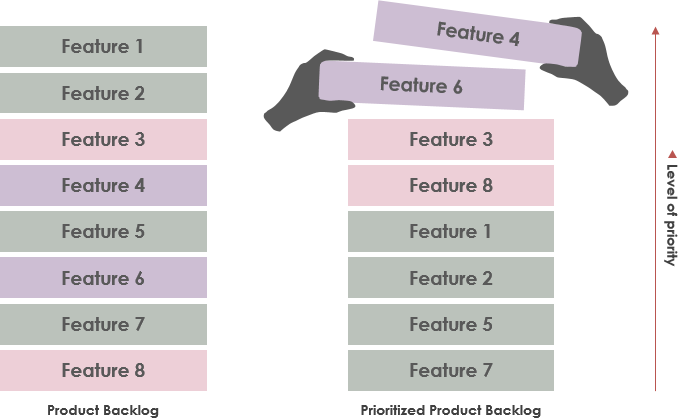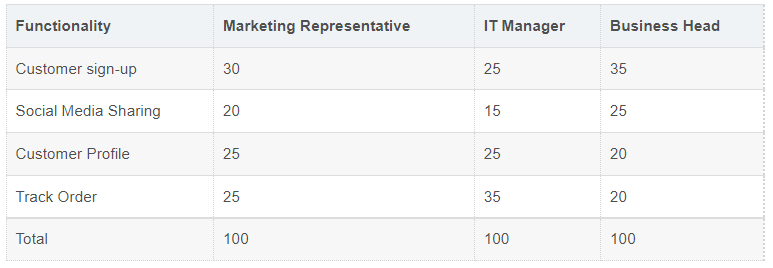اولویتبندی بکلاگ محصول شما مهم است تا اطمینان حاصل شود که به یک لیست بیپایان تبدیل نشود که در آن همه ایدههای تصادفی درباره محصول شما داشته باشند. لیست کارهای شما باید ساختارمند، سازمانیافته و اولویتبندی شده باشد تا مهمترین موارد استراتژیک برای تیم شما شناسایی شود. در این مقاله، من روش ۱۰۰ امتیاز را برای فعالیتهای تصفیه بکلاگ محصول معرفی میکنم.

روش درصدی چیست؟
روش ۱۰۰ امتیازی (که به عنوان روش ۱۰۰ دلاری، مجموع ثابت یا تخصیص ثابت نیز شناخته میشود) توسط دین لفیگول و دان ویدریگ در سال ۲۰۰۳ پیشنهاد شد. هدف این است که به موارد معلق با اولویت بالاتر نسبت به سایر داستانهای کاربری موجود وزن بیشتری داده شود. این شامل دادن ۱۰۰ امتیاز به شرکتکنندگان است. آنها میتوانند به موارد موجود در لیست کارهای محصول، مانند داستانهای حماسی یا کاربری که بیشترین ارزش را برای کسبوکار اضافه میکنند، رأی دهند. برگههای رأیگیری نیازی به توزیع یکنواخت ندارند؛ در عوض، اولویت بالاتر برخی پروژهها میتواند از طریق تخصیص وزنی منعکس شود. پس از اتمام فرآیند رأیگیری، اولویت با محاسبه مجموع امتیازهای تخصیصیافته به هر داستان کاربری تعیین میشود.
روش ۱۰۰ امتیازی چگونه کار میکند؟
همانطور که در بالا ذکر شد، روش ۱۰۰ امتیازی به شرکتکنندگان اجازه میدهد تا ۱۰۰ امتیاز را برای تعیین اولویت پروژههای مختلف تخصیص دهند. امتیازدهی به صورت درصدی بیان میشود و گزینههای محبوبتر در رتبههای بالاتر قرار میگیرند.
در اینجا یک مثال از رویکرد ۱۰۰/۱۰۰ امتیازی برای توسعه سایتهای جدید تجارت الکترونیک آورده شده است:

تصور کنید گروهی از افراد در تلاشند تا پنج مورد را اولویتبندی کنند.
- ۱۰۰ امتیاز به ازای هر نفر.
- یک نفر میتواند تصمیم بگیرد که هر پروژه به یک اندازه مهم است و ۲۰ امتیاز به هر پروژه تخصیص دهد.
- یا، آنها پروژه ۱ را مهمتر از پروژه ۲، پروژه ۲ را مهمتر از پروژه ۳ و به همین ترتیب در نظر میگیرند. در نتیجه، رأیهای آنها بر اساس وزن تخصیص داده شد، با ۴۰ رأی در مورد ۱، ۳۰ رأی در مورد ۲، ۱۵ رأی در مورد ۳ و به همین ترتیب، تا زمانی که تمام رأیها تخصیص داده شده باشد.
- سپس تمام برگههای رأیگیری جمعآوری میشوند تا رأی نهایی برای هر مورد تعیین شود و در نتیجه یک لیست اولویتبندی ایجاد میشود.
نتیجهگیری
گاهی اوقات این رویکرد همچنین به عنوان روش تخصیص ثابت یا ثابت نامیده میشود، زیرا وقتی به شرکتکنندگان همان مجموعه اقلام را میدهیم و از آنها میخواهیم که ۱۰۰ امتیاز به اقلام بکلاگ محصول بر اساس اهمیت نسبی آنها تخصیص دهند.
ما باید مزایا و معایب را در تصمیمگیریهای اولویتبندی بسنجیم. هر چه امتیاز بیشتری کسب کند، امتیاز کمتری به دیگری تعلق میگیرد. آیا این فرآیند رأیگیری دموکراتیک تضمینکننده تصمیمات با کیفیت است؟ این واقعاً به کیفیت و هوش تیم بستگی دارد.
زیرا روش ۱۰۰ امتیازی یک مجموع ثابت را ارائه میدهد، نیاز به ترتیب درست اولویتها دارد تا معتبر در نظر گرفته شود. در غیر این صورت، برخی از رویههای اعتبارسنجی ضروری خواهد بود، اما این ممکن است ارزش تلاش را داشته باشد و همچنین میتوان با برخی ابزارهای نرمافزاری انجام داد.
- بکلاگ محصول در اسکرام چیست؟ چه کسی مسئول آن است؟
- چگونه بکلاگ محصول را تصفیه کنیم؟
- بکلاگ اسپرینت در اسکرام چیست؟
- چگونه بکلاگ محصول را با استفاده از روش MoSCoW اولویتبندی کنیم؟
- چگونه بکلاگ محصول را با استفاده از روشهای ۱۰۰ امتیازی اولویتبندی کنیم؟
- هدف اسپرینت در اسکرام چیست؟
- نمودار سوختن در اسکرام چیست؟
- الگوی نقش-ویژگی-دلیل چیست؟
- افزایش اسپرینت در مقابل محصول قابل ارسال بالقوه در مقابل MVP در مقابل MMP
- اهداف SMART و INVEST را برای داستانهای کاربری بنویسید
This post is also available in Deutsch, English, Español, Français, Bahasa Indonesia, 日本語, Polski, Portuguese, Ру́сский, Việt Nam, 简体中文 and 繁體中文.













